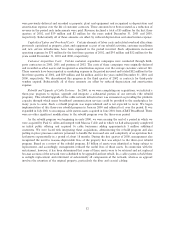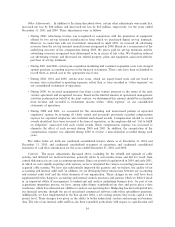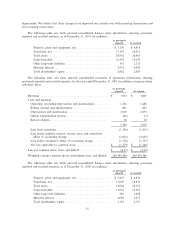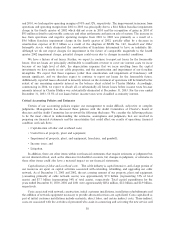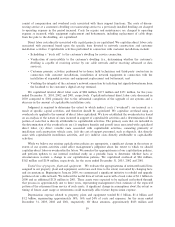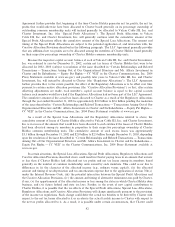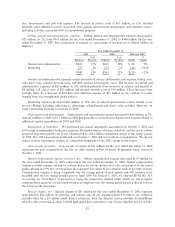Charter 2003 Annual Report Download - page 42
Download and view the complete annual report
Please find page 42 of the 2003 Charter annual report below. You can navigate through the pages in the report by either clicking on the pages listed below, or by using the keyword search tool below to find specific information within the annual report.$352 million for the years ended December 31, 2002 and 2001, respectively, relates to network assets which
were replaced and retired over the three-year period of the rebuild initiative. Depreciation is recorded using
the straight-line method over management's estimate of the estimated useful lives of the related assets as
follows:
Cable distribution systemsÏÏÏÏÏÏÏÏÏÏÏÏÏÏÏÏÏÏÏÏÏÏÏÏÏÏÏÏÏÏÏÏÏÏÏÏÏÏÏÏÏÏ 7-15 years
Customer equipment and installations ÏÏÏÏÏÏÏÏÏÏÏÏÏÏÏÏÏÏÏÏÏÏÏÏÏÏÏÏÏÏÏÏ 3-5 years
Vehicles and equipmentÏÏÏÏÏÏÏÏÏÏÏÏÏÏÏÏÏÏÏÏÏÏÏÏÏÏÏÏÏÏÏÏÏÏÏÏÏÏÏÏÏÏÏÏ 1-5 years
Buildings and leasehold improvementsÏÏÏÏÏÏÏÏÏÏÏÏÏÏÏÏÏÏÏÏÏÏÏÏÏÏÏÏÏÏÏÏ 5-15 years
Furniture and ÑxturesÏÏÏÏÏÏÏÏÏÏÏÏÏÏÏÏÏÏÏÏÏÏÏÏÏÏÏÏÏÏÏÏÏÏÏÏÏÏÏÏÏÏÏÏÏÏ 5 years
Impairment of property, plant and equipment, franchises and goodwill. As discussed above, the net
carrying value of our property, plant and equipment is signiÑcant. We also have recorded a signiÑcant amount
of cost related to franchises, pursuant to which we are granted the right to operate our cable distribution
network throughout our service areas. The net carrying value of franchises as of December 31, 2003 and 2002
was approximately $13.7 billion (representing 64% of total assets) and $13.7 billion (representing 61% of total
assets), respectively. Furthermore, we recorded approximately $52 million of goodwill as a result of the
acquisition of High Speed Access in February 2002.
We adopted SFAS No. 142 on January 1, 2002. SFAS No. 142 requires that franchise intangible assets
that meet the indeÑnite life criteria no longer be amortized against earnings but instead must be tested for
impairment annually or more frequently as warranted by events or changes in circumstances. In determining
whether our franchises have an indeÑnite life, we considered the exclusivity of the franchise, the expected
costs of franchise renewals, and the technological state of the associated cable systems with a view to whether
or not we are in compliance with any technology upgrading requirements. We have concluded that as of
January 1, 2002, December 31, 2002 and December 31, 2003 more than 99% of our franchises qualify for
indeÑnite life treatment under SFAS No. 142, and that less than one percent of our franchises do not qualify
for indeÑnite-life treatment due to technological or operational factors that limit their lives. Costs of Ñnite-
lived franchises, along with costs associated with franchise renewals, will be amortized on a straight-line basis
over 10 years, which represents management's best estimate of the average remaining useful lives of such
franchises. Prior to the adoption of SFAS No. 142, our franchises were amortized over an average useful life of
15 years. Franchise amortization expense related to franchises not qualifying for indeÑnite life treatment
totaled $9 million for each of the years ended December 31, 2003 and 2002. Franchise amortization expense
was $1.5 billion, representing approximately 29% of costs and expenses, for the year ended December 31,
2001. We expect amortization expense on franchise assets will decrease to approximately $4 million annually
based on our ability in 2003 to renew franchise agreements we previously classiÑed as having Ñnite lives
without substantial costs. Actual amortization expense to be reported in future periods could diÅer from these
estimates as a result of new intangible asset acquisitions or divestitures, changes in useful lives and other
relevant factors. Our goodwill is also deemed to have an indeÑnite life under SFAS No. 142.
SFAS No. 144, Accounting for Impairment or Disposal of Long-Lived Assets, requires that we evaluate
the recoverability of our property, plant and equipment and franchise assets which did not qualify for indeÑnite
life treatment under SFAS No. 142 upon the occurrence of events or changes in circumstances which indicate
that the carrying amount of an asset may not be recoverable. Such events or changes in circumstances could
include such factors as changes in technological advances, Öuctuations in the fair value of such assets, adverse
changes in relationships with local franchise authorities, adverse changes in market conditions or poor
operating results. Under SFAS No. 144, a long-lived asset is deemed impaired when the carrying amount of
the asset exceeds the projected undiscounted future cash Öows associated with the asset. Furthermore, we
were required to evaluate the recoverability of our indeÑnite life franchises, as well as goodwill, as of
January 1, 2002 upon adoption of SFAS No. 142, and on an annual basis or more frequently as deemed
necessary.
Under both SFAS No. 144 and SFAS No. 142, if an asset is determined to be impaired, it is required to
be written down to its estimated fair market value. We determine fair market value based on estimated
discounted future cash Öows, using reasonable and appropriate assumptions that are consistent with internal
40




